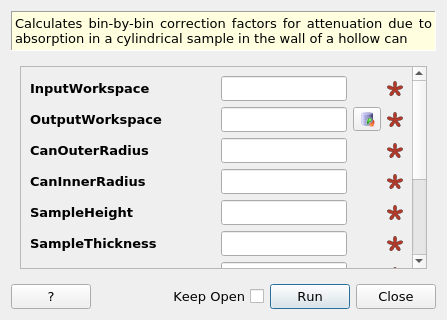\(\renewcommand\AA{\unicode{x212B}}\)
AnnularRingAbsorption v1¶

AnnularRingAbsorption dialog.¶
Summary¶
Calculates bin-by-bin correction factors for attenuation due to absorption in a cylindrical sample in the wall of a hollow can
See Also¶
Properties¶
Name |
Direction |
Type |
Default |
Description |
|---|---|---|---|---|
InputWorkspace |
Input |
Mandatory |
The input workspace in units of wavelength. |
|
OutputWorkspace |
Output |
Mandatory |
The name to use for the output workspace. |
|
CanOuterRadius |
Input |
number |
Mandatory |
The outer radius of the can in centimetres |
CanInnerRadius |
Input |
number |
Mandatory |
The inner radius of the can in centimetres |
SampleHeight |
Input |
number |
Mandatory |
The height of the sample in centimetres |
SampleThickness |
Input |
number |
Mandatory |
The thickness of the sample in centimetres |
SampleChemicalFormula |
Input |
string |
Mandatory |
Chemical composition of the sample material |
SampleNumberDensity |
Input |
number |
Mandatory |
The number density of the sample in number of formulas per cubic angstrom |
NumberOfWavelengthPoints |
Input |
number |
Optional |
The number of wavelength points for which a simulation is atttempted (default: all points) |
EventsPerPoint |
Input |
number |
300 |
The number of “neutron” events to generate per simulated point |
SeedValue |
Input |
number |
123456789 |
Seed the random number generator with this value |
Description¶
Sets up a hollow sample shape, along with the required material properties, and runs the MonteCarloAbsorption algorithm. This algorithm merely serves as a simpler interface to define the shape & material of the sample without having to resort to the more complex CreateSampleShape & SetSampleMaterial algorithms. The computational part is all taken care of by MonteCarloAbsorption. Please see that documentation for more details.
Assumptions¶
The algorithm currently assumes that the can wall is sufficiently thin & a weak absorber so that it can be ignored.
Usage¶
Example
sample_ws = CreateSampleWorkspace("Histogram",NumBanks=1) # fake some data in TOF
sample_ws = ConvertUnits(sample_ws, Target="Wavelength")
factors = \
AnnularRingAbsorption(sample_ws,
SampleHeight=3.8, SampleThickness=0.05, CanOuterRadius=1.1,CanInnerRadius=0.92,
SampleChemicalFormula="Li2-Ir-O3",SampleNumberDensity=0.004813,
EventsPerPoint=300)
print("The created workspace has one entry for each spectra: {}".format(factors.getNumberHistograms()))
print("Just divide your data by the correction to correct for absorption.")
Output:
The created workspace has one entry for each spectra: 100
Just divide your data by the correction to correct for absorption.
Categories: AlgorithmIndex | CorrectionFunctions\AbsorptionCorrections
Source¶
C++ header: AnnularRingAbsorption.h
C++ source: AnnularRingAbsorption.cpp
